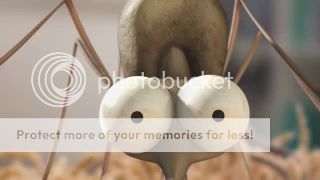Muestra aleatoria
Silente | Silent
Sí, es un colectivo alemán, pero no el clásico subanempujenestrujenbajen, sino el compuesto por Gregor Baumert, Luiza Kurc Botelho, Benjamin Burr, Sebastian Elsner, Julia Hofmann, Cordula Landt, Lionel Maccaud, Marcel Morschhauser, Jan Oberhauser, Annette Selcho, Florian Stanger, Johannes Wolf, respiro.
Stichprobe cuenta las (des)venturas de un ácaro y un mosquito, desde una perspectiva sencillísima, con una puesta en escena simple pero no por ello despojada de complejidad. Y no es que se convierta en un tratado de screwball, pero el humor seco de estos muchachitos alemanes oriundos de Stuttgart, que sin dudas homenajean a Thomas Szabo y Hélène Giraud, creadores de Minuscule, es efectivo.
Y digo efectivo en el mejor sentido de la palabra, el CGI, muchas veces rechazado desde N+2 por deshumanizar la animación, es perféctamente utilizado, con sencillez pero a la vez gran claridad conceptual.
Me criticarán, lo sé, pero este es un GRAN corto.
IA: How did you guys exchange ideas, collaborate...?
At first we would just meet for a beer in the sun or at a café near the university to exchange ideas. Later on, during the production phase, we met every day in the lab at university. First we met in one big group, then once we reached the advanced stages we met in smaller groups so each could do their part of the production. Every other day we would meet with the "heads of departments" (if you can have this in such small group production) and talk about results and progress. We were kind of lucky because the motion control stage is not far from the CG and IM lab, only about 3 floors, so the exchange was very fast and direct like: "Hey, we got something here, have a look!"
IA: From the initial design to the final movie were there any major difficulties?
If you do a stop motion project with a scale model environment in the studio and real scenarios on-location, combined with CG elements, your biggest trouble is having the whole workflow in foresight. What does this decision entail and what are the steps. You have to ask yourselves, how much more work will it be in the compositing if we shoot this picture with a reflecting underground? What does this camera movement mean for the movements of the 3D character you will be adding later?
Later on, from the CG point of view, we had some difficulties dealing with the uncertainties in addition to the usual stuff. Some of you reading this article may have worked with Maya so you probably know what I'm talking about: crashes happen when you don't need them, 0 KB files after rendering...
Besides that we had a few "positive" difficulties. There were many long shots where Milbert, one of our main characters, had to walk but we didn't want to animate an entire eight feet by hand so we designed an automatic rig. You could just grab it, move it and all eight feet would move automatically. There were also a few annoying tasks to do. We used the motion control arm for doing camera animations and these animations could be designed in Maya and then converted to Motion Control arm compatible data. In some cases, especially when we did a camera roll, they never fit with the image sequence and we ended up doing the tracking with Boujou for some shots.
IA: What was the part(s) you enjoyed working on the most?
Personally, I like to do animation. This was also a first for me because I'd never done cartoon characters of 8 feet before, there was a lot to play around with. And of course seeing everything coming together...suddenly everything that was done for some elusive reason finally makes sense..
IA: Can you tell us about the tools you used?
For CG we mainly used the standard software. Maya 2008 with Mental Ray for network rendering; Smedge (in an quite old version), Photoshop and Bodypaint for textures and Fusion for compositing. We did shoot on RAW files so we used Lightroom for grading.
IA: How long did it take you to create this short film?
The movie had to be done in less than 12 weeks, which is a semester.
IA: For those who know "Minuscule", your film looks like a great tribute to the series. Were you very inspired by it? What were your other sources of influence?
Yes of course, we were inspired by "Minuscule". Our way of telling the story (if we even have one, our professors weren't really sure :)) is very close to the storytelling of "Minuscule". But as said earlier, the character design is really our own. We also looked at all kinds of cartoons, our characters are quite cartoon like with their big white eyes.
IA: Are you working on any new projects now?
Well, as we are going into a new semester we will start, some of us are going away for internships and others, like me, are doing their bachelor thesis.
At first we would just meet for a beer in the sun or at a café near the university to exchange ideas. Later on, during the production phase, we met every day in the lab at university. First we met in one big group, then once we reached the advanced stages we met in smaller groups so each could do their part of the production. Every other day we would meet with the "heads of departments" (if you can have this in such small group production) and talk about results and progress. We were kind of lucky because the motion control stage is not far from the CG and IM lab, only about 3 floors, so the exchange was very fast and direct like: "Hey, we got something here, have a look!"
IA: From the initial design to the final movie were there any major difficulties?
If you do a stop motion project with a scale model environment in the studio and real scenarios on-location, combined with CG elements, your biggest trouble is having the whole workflow in foresight. What does this decision entail and what are the steps. You have to ask yourselves, how much more work will it be in the compositing if we shoot this picture with a reflecting underground? What does this camera movement mean for the movements of the 3D character you will be adding later?
Later on, from the CG point of view, we had some difficulties dealing with the uncertainties in addition to the usual stuff. Some of you reading this article may have worked with Maya so you probably know what I'm talking about: crashes happen when you don't need them, 0 KB files after rendering...
Besides that we had a few "positive" difficulties. There were many long shots where Milbert, one of our main characters, had to walk but we didn't want to animate an entire eight feet by hand so we designed an automatic rig. You could just grab it, move it and all eight feet would move automatically. There were also a few annoying tasks to do. We used the motion control arm for doing camera animations and these animations could be designed in Maya and then converted to Motion Control arm compatible data. In some cases, especially when we did a camera roll, they never fit with the image sequence and we ended up doing the tracking with Boujou for some shots.
IA: What was the part(s) you enjoyed working on the most?
Personally, I like to do animation. This was also a first for me because I'd never done cartoon characters of 8 feet before, there was a lot to play around with. And of course seeing everything coming together...suddenly everything that was done for some elusive reason finally makes sense..
IA: Can you tell us about the tools you used?
For CG we mainly used the standard software. Maya 2008 with Mental Ray for network rendering; Smedge (in an quite old version), Photoshop and Bodypaint for textures and Fusion for compositing. We did shoot on RAW files so we used Lightroom for grading.
IA: How long did it take you to create this short film?
The movie had to be done in less than 12 weeks, which is a semester.
IA: For those who know "Minuscule", your film looks like a great tribute to the series. Were you very inspired by it? What were your other sources of influence?
Yes of course, we were inspired by "Minuscule". Our way of telling the story (if we even have one, our professors weren't really sure :)) is very close to the storytelling of "Minuscule". But as said earlier, the character design is really our own. We also looked at all kinds of cartoons, our characters are quite cartoon like with their big white eyes.
IA: Are you working on any new projects now?
Well, as we are going into a new semester we will start, some of us are going away for internships and others, like me, are doing their bachelor thesis.

LINK
http://www.mediafire.com/?o9130l8kn6wxcyh






































